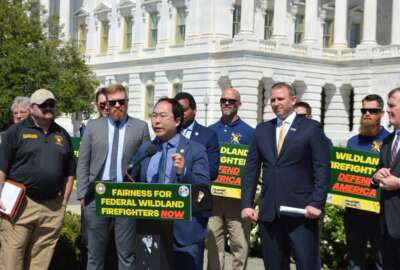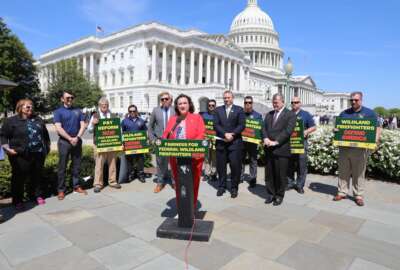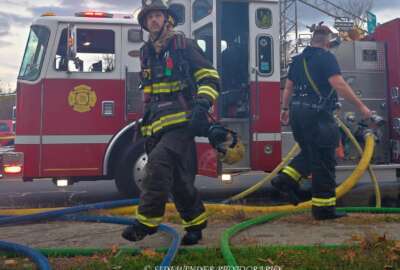The push is on to improve pay for the nation’s federal firefighters
A bill with bipartisan backing would give substantial raises to federal firefighters. Their union says they make close to minimum wage for this dangerous work, and...
A bill with bipartisan backing would give substantial raises to federal firefighters. Their union says they make close to minimum wage for this dangerous work, and they haven’t had a raise in a generation. For more on the Federal Firefighter Pay Equity Act, Federal Drive with Tom Temin spoke with Greg Russell, the government affairs representative of the International Association of Firefighters.
Interview Transcript:
Tom Temin And tell us the situation for the federal firefighting force. I guess two of the departments each have firefighters. About 5000 in one, about 12,000, I think in the other. What is their pay situation now?
Greg Russell Well, so let’s define who the firefighters are. There are approximately 9500 federal firefighters that answer 911 calls on federal installations all across the United States. They’re located in 46 states, and they are an all hazards firefighting force. So they respond to fire emergencies, vehicle accidents, hazardous materials spill and emergency medical service calls. Their situation with their pay is this: They earn approximately two thirds of the hourly rate pay to a general schedule government employee. Their average hourly rate across the United States is $16.26 an hour. In Hawaii, where you have an incredibly high cost of living, the average hourly rate is $14.55. Compare that to Mississippi, generally a smaller economy, if you will. In Mississippi, it’s $15.85 an hour is the average hourly rate for these firefighters. So we need to address their hourly pay, which will help with recruitment and retention. We’re currently seeing between 15 and 20% vacancies across the federal government. And again, this is just structural firefighters. This does not include the wildland our firefighters here, do not primarily respond to wildland fires. That’s a complete separate federal occupation.
Tom Temin At that pay level, then, how does that compare to, say, if you’re in Honolulu or if you’re in a city that municipal fire department levels of pay.
Greg Russell The pay is approximately a third to half of the neighboring municipality. And oftentimes, our firefighters, federal firefighters are responding hand in hand with the municipality. In our D.C. metro area where I’m located, we have the National Institutes of Standards and Technology, the National Institutes of Health and the Department of Navy, all located within Montgomery County, Maryland. As part of a mutual aid agreement, those agencies respond to fires and incidents in Montgomery County. So they’re standing side by side with Montgomery County firefighters saving the lives and property of the Maryland citizen. This is not just in Maryland. This happens all over. In fed fire San Diego, they respond to incidents with the municipalities there. We have to do this firefighting evolution by joining our forces together. There is no way that one entity alone can handle all your emergencies. We have this integrated mutual aid system which takes our firefighters from the federal facility out into the municipal sector and then also brings the municipal sector into the fed sector.
Tom Temin Tell us more about the Federal Firefighter Pay Equity Act. What would that specifically do? And does it go far enough, in your view?
Greg Russell The Federal Firefighter Pay Equity Act is an incremental step of moving the ball forward. So that bill would level the playing field for the hourly wage, when you compare grades. A firefighter is typically a GS-5 to a GS-7. Again, they’re making two thirds of what the typical GS-5, GS-7 makes. So they will see their pay elevated to the same hourly rate. Another flaw, if you will, in the current benefit scheme is federal firefighters do not receive full compensation or full consideration for their high three when their retirement benefits are calculated. We intend to increase their high three figure to the amount they earn for their regularly reoccurring 72 hour workweek. A federal firefighter typically works 3744 hours a year. However, not the total of that 3744 hours counts towards their retirement. Each pay period, they’re reduced approximately 19 hours when it comes to their retirement calculation. Well over 26 pay periods,19 hours adds up to a substantial amount, which lowers their high three calculation, about 5000 to $7000, depending on their grade.
Tom Temin We’re speaking with Greg Russell. He’s government affairs representative of the International Association of Firefighters. And just give us a sense of how they live when they’re on duty. Because I live in Montgomery County, Maryland, and there are volunteers and there are full time sworn firefighters and they have nice firehouses. And it’s almost like you see on these TV shows and when the fire comes, they’re ready. But meanwhile, life is not bad in the firehouse. What is it like for the feds.
Greg Russell The federal fire sector is very much similar to the municipal sector. One thing that I will share that is different than what you see on TV, is most of the federal facilities are well dated. For example, we still have a fire station fully occupied and in service 24 hours a day here in the District of Columbia that was built in the 1800s. That building is at the Washington Navy Yard. There are other departments out there that I am aware of that are living in cramped quarters because the buildings are so old that they haven’t kept up with the modern apparatus. Imagine the size of a vehicle, a fire engine from the 1950s, and compare that to a fire engine you see today. The current fire engine is probably two feet wider and 6 to 8 feet longer and maybe a foot or two taller. That takes up valuable real estate, if you will, and what sacrifices is the living quarters. Federal firefighters do not enjoy single occupant bunk rooms. Most of them have three or four, even ten or 12 firefighters sleeping in a single room. And that is if they can sleep and they are working 24 hours a day. So they have kitchen facilities and the kitchens are often gated, very small, cramped. Many fire stations do not have training facilities like you find in modern fire stations. So as far as fire station facilities go across the board, they could use modernization. We are talking about all agencies. So the largest employer of federal firefighters is the Department of Defense, followed by Veterans Affairs. But again, you have federal firefighters at Commerce, at Health and Human Services, at Interior at Energy, Department of Homeland Security with Coast Guard facilities. So they’re across the board when it comes to agencies. But DoD is by far the largest employer, and they’re the ones suffering the highest attrition at this time.We have the Norfolk Navy base, the largest naval base in the free world, currently has between 50 and 60 vacant firefighter positions. Folks do not want to go to work for the Navy who are paying wages substantially below the municipal counterparts and our federal firefighters, again, like I said, work a 72 hour workweek as opposed to a typical municipal employee who works between 52 and 56 hours each week. So we work more hours for less money in the federal sector. And that’s the third part of our bill. The third part of our bill went direct the Office of Personnel Management to determine the maximum number of hours a federal firefighter can be regularly scheduled, provided that maximum is no more than 60 hours. So the Office of Personnel Management could determine that 56, which is comparable to municipal firefighters, is appropriate and set it at that. But at no case would it be more than 60 hours.
Tom Temin Right. So two and a half days. And we should point out that 3744 hours a year at $16 an hour, that only comes out to just below $60,000. So it’s not like they’re getting giant pay here for these long hours.
Greg Russell That’s correct.
Tom Temin How does these firefighters pay compare to the federal wildfire firefighters? We are having a temporary pay boost through the one of the bills, and that’s about to expire at the end of the fiscal year.
Greg Russell Correct. These firefighters did not receive that approximately $20,000 a year pay boost. These firefighters still are making just above minimum wage in many states. In comparison, their gross salaries are about the same when you consider all the overtime that goes into wildland firefighting.
Tom Temin Sure. And getting back to this bill, does it have a Senate and a House counterpart? And what do you think the prospects are right now given Congress?
Greg Russell So it is a bipartisan bill in the House and we are in discussion with folks on the Senate side. At present, I am optimistic that we can gain some traction. Today, from what I understand, the House will take up the National Defense Authorization Act and that will include pay boost for our low ranking military people. Well, when you consider that these federal firefighters are sworn to protect those military people, they deserve a wage that is comparable, if not more, for somebody that risked their life day in and day out than a typical military member on the home front. When they’re in a combat zone, they certainly deserve every penny they earn. But many military occupations in the homeland are not in a risky position, whereas firefighting, regardless of state, municipal or federal, is a group one carcinogen as determined by the International Agency for Research on Cancer. That means just by being a firefighter, you have the likelihood of contracting cancer on par with somebody that has unprotected exposure to nuclear energy.
Copyright © 2025 Federal News Network. All rights reserved. This website is not intended for users located within the European Economic Area.
Tom Temin is host of the Federal Drive and has been providing insight on federal technology and management issues for more than 30 years.
Follow @tteminWFED






